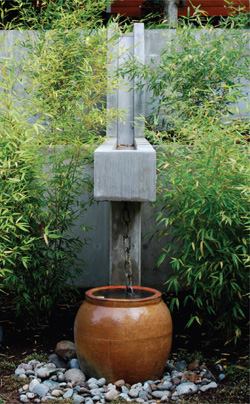Photo: Samuel H. Williamson The terrace fills a void created by the U-shaped house, and the family can enter it from living spaces on three sides. Normally, Williamson says, the outdoor areas next to the house would be the most civilized, becoming progressively more natural as they radiate outward. “I like to throw a wrench into that idea every now and then and pull something really natural up against the house,” he says. In this case he was also shielding the house’s south-facing side and big bank of windows from the hot sun. “The function of these birches was to create tall, feathery shade but still let light into the house,” he says. “The runnel is like a stream wending its way around the trunks of the trees, and in that enclosed space the sound of the water is noticeable—a nice white noise.”
Williamson created something entirely different with runnels outside a newly constructed Seattle home. There, the sunken channels draw people from the Modernist house to a remote upper terrace. “We were either going to turn our back on it and make it go away, or draw people to it,” he says. “Water is a wonderful way to do that.” The water comes in through a slot in the back of a trough in the upper terrace, evoking a spring-fed pond. Three concrete runnels then travel down the slope through a bamboo grove and cantilever over the grade change, pouring water down heavy chains into earthen pots below.
Installing a runnel is a fairly simple operation, usually done by a landscape contractor. At the Seattle house, they’re made of cast concrete with shiny stainless steel bands on the bottom to convey the look of water even when it’s turned off. The Dover garden’s runnel is lined with river rock, which helps animate the water if the runnel is shallow. The smooth pebbles are also useful for hiding mechanical underpinnings like tubes and the metal grille covering the pump chamber.
In the Seattle garden the water canals cantilever off an upper terrace, connecting the two levels. Reservoirs under the urns collect water that pools there when the pump is turned off. Photo: Samuel H. Williamson Williamson likes to orchestrate the flow of water at different points along the canal. Flow rate is controlled by the runnel’s depth, width, and volume of water, and by adjusting the pump or creating a weir that causes water to pool and then rush over the top. “Make the water shallow—about ½ inch—if you want to see it moving,” Williamson advises. “One thing we’ve learned recently is that if the water is very deep, it doesn’t feel like it’s moving until it reaches the next dropping-off point.” To discourage algae growth, the pump is typically placed at the opposite end of the runnel from the point of origin. Shallow runnels should be sloped to encourage the downhill flow, although this means water will collect at the bottom when the pump is turned off. The solution is to create a bottom pool that can hold the extra water.
A runnel brings people closer to nature, to the sound of water, and to a feeling of tranquility enjoyed in a garden. —Cheryl Weber is a contributing writer in Lancaster, Pa.
Photo: Samuel H. Williamson
(Above, left) A serpentine runnel and birches cool a south-facing courtyard. The designer edged the canal in granite fieldstone and used white limestone and bluestone paving to draw the eye toward the view.
Landscape architect: Samuel H. Williamson Associates; Landscape contractor: Greeno Tree Spade, Hudson, N.Y. Photo: Samuel H. Williamson CALLBACK In the Spring 2008 issue (Walk this Way, page 22), the location of Julie Moir Messervy Design Studio was incorrect. The studio is located in Saxtons River, Vt. For more information visit www.jmmds.com.



